How to Get Rid of Drain Flies in Your Home, According to Pest Experts

One pesky fly buzzing around the house is enough to drive you crazy—having hundreds of tiny ones swarming the drains in your kitchen or bathroom is considerably worse. Drain flies are a nuisance no one wants to see in their home, especially because they’re not the kind of pests that are likely to depart on their own. Thankfully, there are actions you can take to stop them in their tracks, and we’ve consulted experts for the best tips and tricks. Read on to learn how to get rid of drain flies in your home.
RELATED: How to Get Rid of Gnats.
What Are Drain Flies?
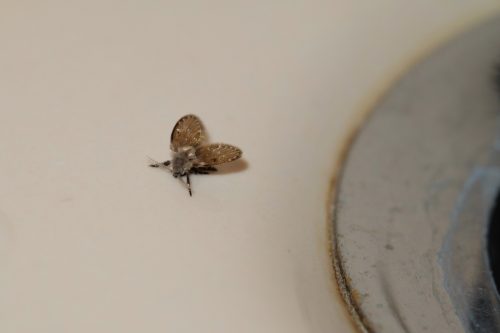
“Drain fly” is just one of the names you’ll hear people use when they’re talking about the Psychodidae insect, which is a “fly that has a moth-like appearance,” according to Jeremy Yamaguchi, pest expert and CEO of Lawn Love.
“You might hear people refer to these flies as ‘sink flies,’ ‘moth flies,’ ‘sewer flies,’ ‘filter flies,’ and even ‘sewer gnats,'” Yamaguchi explains.
Drain flies are pretty small, coming in at around 1/16 to 1/8 of an inch long, says Daniel Brown, pest control and cleaning expert for Handy Cleaners.
“This pest is fuzzy, grey-brown in color, and also has long, slender wings with a ‘T’ shape on the end—much like moths,” he tells Best Life. “They’re generally found in damp areas near drains, sinks, and other standing water sources.”
Are Drain Flies Harmful?
Unlike some of the other pests that might find their way into your home, drain flies “are usually not a threat to humans,” according to Patrick Sullivan, plumbing professional and operations manager at John The Plumber.
“They neither bite nor sting, and there is no evidence suggesting they spread diseases,” he notes.
Still, their presence can be unsettling and quickly turn into a nuisance.
“Not only that, but they can also potentially carry and spread bacteria, as well as other contaminants, from the drains they breed in,” warns Nathan Thorne, pest controller, gardening landscaping expert, and horticulturist at Handyflowers.
RELATED: How to Get Rid of Boxelder Bugs, According to Pest Experts.
Drain Flies vs. Fruit Flies
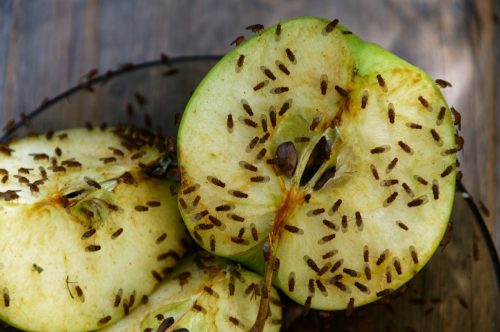
People often confuse drain flies and fruit flies, but they are two distinctive kinds of flies. While both are small in stature, a fruit fly’s body is smoother and shinier compared to the drain fly’s fuzzy appearance, according to Sullivan.
They are also attracted to different areas in your home.
“Drain flies tend to hover near drains and fly slowly, while fruit flies are more agile and are commonly seen around food items, like overripe fruits and vegetables,” Sullivan explains.
Why Are There So Many Drain Flies in My House?
Drain flies might be more noticeable during the summer because they’re more active during warmer and humid seasons, according to Brian Davis, environmental health technician and sanitation expert at Handy Rubbish.
But as to why they may be invading your home specifically, it’s important to remember that these flies are attracted to damp areas.
“So if there is a leak in your pipes or high condensation in your area, they are bound to come around,” Davis says.
Clogged drains also provide the “ideal breeding ground” for drain flies, because they allow stagnant water to sit in your pipes and organic matter to pile up in them, creating a food supply source for drain flies too, he adds.
RELATED: How to Get Rid of Cockroaches.
How to Get Rid of Drain Flies
Now that you know what they look like and why they’ve made their home in yours, you’re probably wondering how to deal with a drain fly infestation. Here are five methods pest experts recommend trying.
1. Make an apple cider vinegar trap.

One of the easiest ways to eliminate drain flies involves using apple cider vinegar, says Ronnie Kendrick, founder of the Colorado-based house cleaning service CompanyClean.
“Grab a small bowl or cup, and fill it with apple cider vinegar. Then put some plastic wrap on top and poke some holes in it,” he advises. “The flies like the smell, and will get caught in the liquid and plastic.”
Kendrick says he’s had to use this method in his own home a few times after getting food caught in the drain. But there’s one caveat to note about the apple cider vinegar tap: “This only works with adult drain flies,” Kendrick cautions.
2. Pour a vinegar and baking soda mixture down the drain.
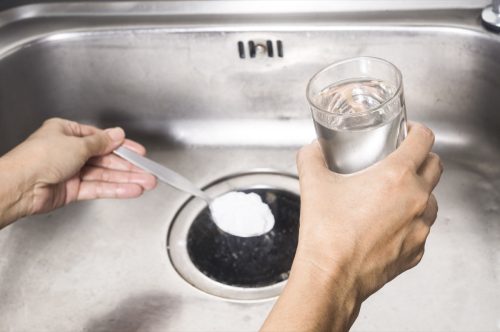
Another natural elimination method requires two ingredients instead: vinegar and baking soda. For this, Davis says you should start by pouring a cup of baking soda down the drain, and then follow that with a cup of white vinegar. You then need to allow the mixture to fizz up for around 15 minutes before you flush it with boiling water.
“The acid-base reaction between the vinegar and the baking soda helps in breaking down the organic matter and cleaning the drain, which becomes unappealing to flies,” Davis explains.
RELATED: How to Get Rid of Ants in the Kitchen.
3. Try the boiling water trick.
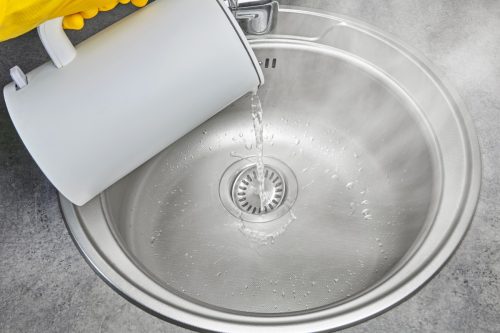
If you want to go for the simplest (and chepeast) option, all you need is the water from your sink and a pot. Over the course of a week, boil a pot of water and pour it down the affected drain one to two times each day, according to Brown.
“This should loosen any water or debris that could be attracting these flies, along with killing adult flies and eggs,” says Brett Bennett, director of operations for PURCOR Pest Solutions.
4. Utilize store-bought cleaners.
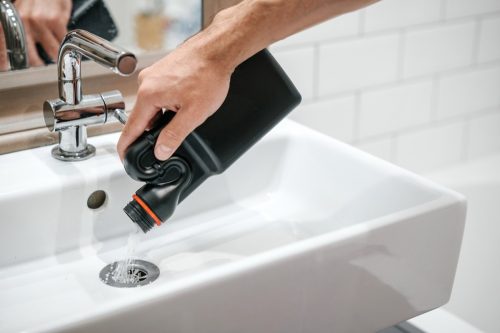
While it would be nice to image that boiling water could easily eliminate all drain flies, Bennett tells Best Life that he has seen infestations where that method doesn’t work.
“In that case, I recommend moving on to bleach,” he suggests. “Pouring a cup of bleach down your drain is sure to kill any flies in the area, although you may need to repeat this a few times to eliminate them all.”
You can also buy commercial drain cleaners to deal with the problem, according to Davis.
“Such cleaners break down organic matter and other debris with robust chemicals, ultimately removing the breeding ground for drain flies,” he notes.
If you want to go for a more eco-friendly method, you can purchase enzyme cleaners, which “digest the organic material by use of enzymes, and as such, they clean the drains without any use of chemicals,” Davis explains.
5. Manually clean out the drain yourself.

If you’re not too enthused about pouring anything down your drain, you can “unscrew the drain and brush the inside of it by hand using a metal pipe brush or pipe cleaner,” Thorne recommends.
“This method allows you to physically remove the buildup and with it, the breeding ground for the drain flies and their population,” Brown adds.
RELATED: How to Get Rid of Bed Bugs the Easiest Way Possible.
How Can I Prevent Drain Flies From Coming Back?
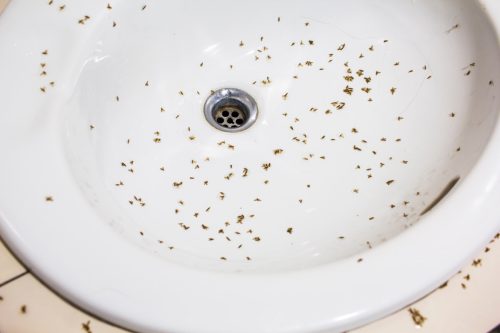
If you’ve finally managed to get rid of your drain fly infestation using any of the above methods, you want to make sure you also keep them from coming back. Fortunately, there are a few prevention methods that can help you stave off their return. Here are three ways pest experts say you can keep drain flies from coming back.
1. Keep your drains clean and clear.
Regular cleaning is one of the best ways to get rid of drain flies and prevent them from coming back. You should use a drain brush and cleaning solutions every so often to prevent buildup in your drain, even when you aren’t experiencing an active infestation, according to Sullivan.
“This will help keep drains clear of organic debris and well-maintained,” he shares.
2. Keep your drains covered.
Drain flies can’t infest your home if they can’t get into their preferred areas. That’s why HVAC and plumbing expert Courtney Zalesak recommends using drain screens or covers, which can “help block drain flies from entering while still allowing water to flow through.”
Zalesak also recommends that homeowners check for any cracks or gaps in their drains, pipes, and plumbing fixtures. If there are any, you should seal them immediately to further “eliminate access points for drain flies to get in.”
3. Make sure you have proper ventilation.
As many experts have pointed out, drain flies thrive in damp areas because they are attracted to moisture. But “good ventilation in both your kitchen and bathroom would prevent moisture from getting out of control,” Brown points out.
Without high moisture levels, drain flies have a harder time reproducing—which means that proper ventilation can help prevent a full-blown drain fly infestation, Brown explains.
RELATED: 6 Things Attracting Moths to Your Closet—And How to Get Rid of Them.
Wrapping Up
That’s it for our guide on how to how to get rid of drain flies, so you can make sure your kitchen and bathroom stay pest-free. But be sure to check back with us soon for more content that can help you eliminate infestations and keep your home clean.